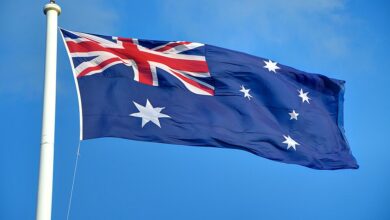
BODALLA, Australia (AP) — Crews battling Australia’s wildfires said Sunday that they have been able to turn from defense to offense for the first time in weeks thanks to a break in the weather.
Dale McLean, who is helping manage the response to a fire near the town of Bodalla in New South Wales state, was part of team that was bulldozing down small trees and burning scrub ahead of the fire’s projected path to try to stop it from reaching a major highway by starving it of fuel.
“This fire took a major run about seven or eight days ago, and with the weather changing now, the weather settling down, the fire has settled down,” he said. “The fire behavior has changed. So we’re able to get in front of the fire now, get on the offensive.”
Other workers echoed McLean’s comments, saying cooler temperatures and mild winds have finally offered them a chance to make progress. The weather is expected to remain benign for the next week, although any deterioration in conditions after that could see the wildfires flare up again.
While battling the blazes, volunteer firefighting veteran Mick Stain found some moth larvae, or “witchetty grubs,” and turned them into what’s known in Australia as bush tucker by roasting them directly on the fire’s burning coals.
“Bit creamy and nutty, but they’re all right,” Stain said. “They’re not spew-worthy, so they’re pretty good.”
The progress made by the crews came after a firefighter was killed by a falling tree. Bill Slade — one of the few professionals among mainly volunteer brigades battling blazes across southeast Australia — died on Saturday near Omeo in eastern Victoria state, Forest Fire Management Victoria Executive Director Chris Hardman said.
The 60-year-old married father of two was commended in November for 40 years of service with the forestry agency.
“Although we do have enormous experience in identifying hazardous trees, sometimes these tree failures can’t be predicted,” Hardman said. “Working on the fire ground in a forest environment is a dynamic, high-risk environment and it carries with it significant risk.”
The tragedy brings the death toll to at least 27 in a crisis that has destroyed more than 2,000 homes and scorched an area larger than the US state of Indiana since September. Four of the casualties have been firefighters.
The crisis has brought accusations that Prime Minister Scott Morrison’s conservative government needs to take more action to counter climate change, which experts say has worsened the blazes. Thousands of protesters rallied Friday in Sydney and Melbourne, calling for Morrison to be fired and for Australia to take tougher action on global warming.
The prime minister said Sunday that his government was building resilience to the fire danger posed by climate change.
He said the government was developing a national disaster risk reduction framework within the Department of Home Affairs that will deal with wildfires, cyclones, floods and drought.
“This is a longer-term risk framework model which deals with one of the big issues in response to the climate changing,” Morrison said.
He said his government accepted that climate change was leading to longer, hotter and drier summers, despite junior government lawmaker George Christensen posting on social media over the weekend that the cause of the latest fires was arson rather than man-made climate change. Another junior lawmaker, Craig Kelly, has also publicly denied any link between climate change and fire crisis.
State authorities have said a minority of fires are deliberately lit.
“The government’s policy is set by the Cabinet. Our party room has a broad range of views,” Morrison said of those within government ranks who reject mainstream climate science.
Morrison also announced that 76 million Australian dollars ($52 million) would be spent on providing psychological counseling for firefighters and fire-affected communities as part of a previously announced AU$2 billion ($1.4 billion) recovery fund.
“There has been a deep scar in the landscape that has been left right across our country,” Morrison said. “But I am also very mindful, as is the government, of the very real scars that will be there for quite a period of time to come for those who’ve been exposed to the trauma of these bushfires.”
While the fire threat is most acute in rural communities, wildfire smoke that has choked some of Australia’s largest cities is a reminder to many urban Australians of the unfolding disaster.
___
Associated Press writer Rod McGuirk in Canberra, Australia, contributed to this report.
Image: A firefighter keeps an eye on a controlled fire as they work at building a containment line at a wildfire near Bodalla, Australia, Sunday, Jan. 12, 2020. Authorities are using relatively benign conditions forecast in southeast Australia for a week or more to consolidate containment lines around scores of fires that are likely to burn for weeks without heavy rainfall. (AP Photo/Rick Rycroft)




